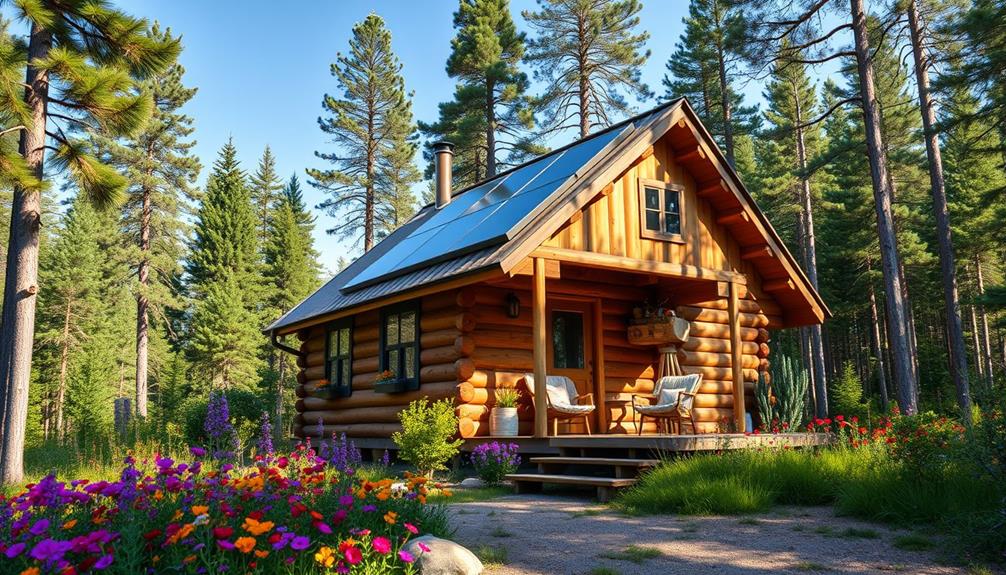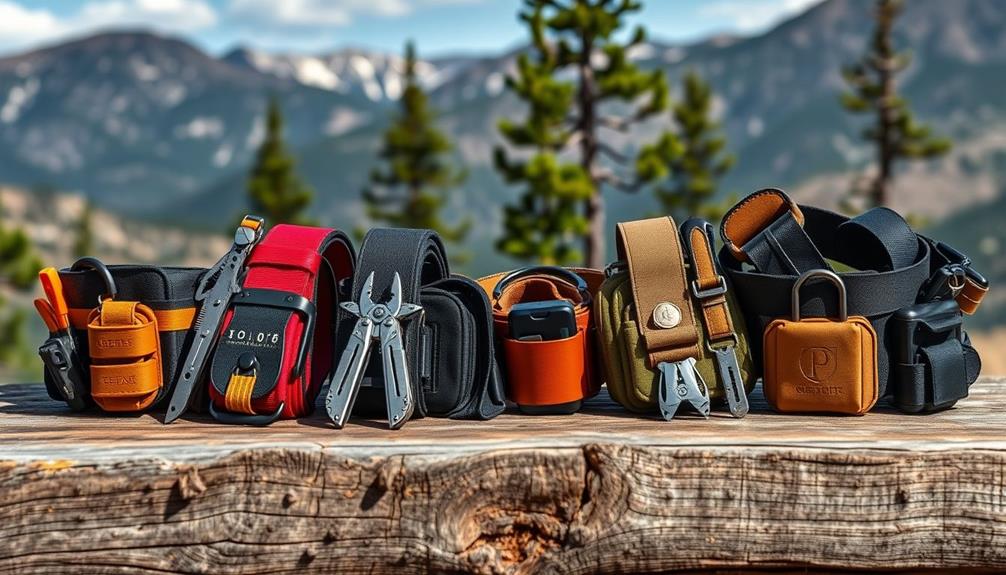Mastering survival bread gives you essential recipes that keep you nourished during tough times. You can start with classic hardtack, which is simple and lasts for years. Just mix flour, water, and salt, then bake until dry. Pilot bread adds versatility; you can enjoy it sweet or savory. If you're looking for something unique, try bannock or damper, both perfect for outdoor cooking. Whole grain options boost your nutrition and support digestive health. With proper storage, these breads remain fresh and accessible. There's so much more to explore, so keep going to discover even more recipes and tips.
Key Takeaways
- Classic Hardtack Recipe: Combine flour, water, and salt; bake until hard for a durable survival bread that lasts for years.
- Versatile Pilot Bread: Use as a base for savory or sweet toppings, or crumble into soups for added texture and nutrition.
- Bannock and Damper: Simple, adaptable recipes perfect for outdoor cooking; can be baked, fried, or cooked over fire with minimal ingredients.
- Whole Grain Benefits: Incorporate whole grain bread for better digestive health, increased fiber, and essential nutrients that support overall well-being.
- Storage Techniques: Keep survival breads in airtight containers in a cool, dry place to maximize shelf life and freshness.
Overview of Survival Breads

Survival breads are essential staples designed for longevity and nutrition, offering a reliable food source in emergencies or outdoor adventures.
These breads come in various types, each tailored for specific needs and preparation methods. Hardtack, for instance, is a classic option known for its durability, while pilot bread offers versatility with different textures.
Bannock and damper provide unique flavors and cooking methods, making them excellent choices for bush cooking. Field bread and iron ration bread cater to military rations, prioritizing portability and palatability.
Whole grain bread stands out for its higher fiber content, supporting digestive health.
Each type of survival bread guarantees you're well-equipped for unexpected situations, keeping you nourished and sustained.
Classic Recipes for Hardtack

When you're looking to create a reliable and long-lasting food source, classic recipes for hardtack are a great place to start.
To make hardtack, mix two cups of flour, half a cup of water, and a pinch of salt. Knead the dough until it's smooth, then roll it out to about half an inch thick. Cut it into squares or rectangles, and poke holes in the center for even baking.
Bake at 375°F for 30 to 40 minutes until it's hard and dry. Let it cool completely before storing in an airtight container.
This simple recipe yields a durable bread that lasts for years when stored properly, providing sustenance during tough times. Enjoy your hardtack with water or broth for a better experience!
Versatile Pilot Bread Options

Pilot bread stands out as a reliable staple for those seeking durability and versatility in their food options. You can enjoy it in various ways, making it an excellent choice for any situation. Whether you're hiking, camping, or preparing for emergencies, pilot bread adapts to your needs.
| Option | Description |
|---|---|
| Savory Snacks | Top with cheese, jerky, or spreads. |
| Sweet Treats | Add honey, jam, or nut butter for a boost. |
| Soups and Stews | Crumble into dishes for added texture. |
| Breakfast Base | Pair with eggs or oatmeal for a hearty start. |
With its long shelf life and simple ingredients, pilot bread is your go-to for tough times. Embrace its versatility and discover your favorite combinations!
Exploring Bannock and Damper

Bannock and damper are two remarkable types of bread that have stood the test of time in outdoor cooking.
Bannock, with its Scottish roots, is an unleavened bread that you can bake, fry, or cook over an open fire. Its simplicity makes it perfect for camping or survival situations. You can easily adapt the recipe by adding herbs or dried fruits for flavor.
On the other hand, damper is a traditional Australian bread made with self-rising flour and water, often cooked in the coals of a campfire.
It's straightforward and requires minimal ingredients, making it a practical choice for bush cooking. Both breads offer versatility and can be a comforting staple during tough times.
Nutritional Insights on Whole Grains

Whole grains are a powerhouse of nutrition, offering a range of benefits that can greatly enhance your diet. They contain the entire grain kernel, including the bran, germ, and endosperm, which means you're getting more fiber, vitamins, and minerals compared to refined grains.
Eating whole grains supports digestive health and can aid in managing conditions like gout nutrition by providing essential nutrients. They also help regulate blood sugar levels and can reduce the risk of chronic diseases like heart disease and diabetes.
Plus, their higher fiber content keeps you feeling full longer, aiding in weight management. When you incorporate whole grain bread into your meals, you're not just adding flavor; you're fueling your body with essential nutrients that can sustain you in tough times.
Unique Varieties: Sourdough and More

What makes sourdough bread stand out among survival breads? Its unique fermentation process using wild yeast gives it a tangy flavor and chewy texture that you won't find in standard survival breads.
Plus, sourdough is nutrient-rich, packed with probiotics that support gut health—essential during tough times. Unlike other breads, it requires a bit more attention in storage to maintain its freshness, but the rewards are worth it.
Beyond sourdough, consider varieties like flatbreads for their versatility and ease of preparation. Gluten-free options cater to dietary needs, while banana or sweet breads can lift spirits with their comforting flavors.
Each variety offers a unique twist, ensuring you don't just survive, but thrive with delicious, satisfying bread.
Emergency Preparedness Essentials

When it comes to emergency preparedness, having a well-rounded food supply is essential, and survival breads play a key role in that plan.
These breads, like hardtack, pilot bread, and bannock, offer long shelf lives and nutritional value, making them perfect staples in your emergency kit.
Pair them with canned foods and dried fruits to guarantee a varied diet during tough times.
Don't forget to include a variety of textures and flavors to keep meals interesting.
Prepare by stocking different types of survival bread, and consider your family's dietary needs too.
Regularly check your supplies to maintain freshness and quality, so you're always ready for unexpected situations or natural disasters.
Proper Storage Techniques for Longevity

Effective storage techniques are essential for guaranteeing the longevity of survival breads. To start, always keep your bread in airtight containers to prevent moisture from spoiling them.
A cool, dry place is ideal; avoid areas with fluctuating temperatures or high humidity. Regularly check your storage conditions, as even small changes can impact freshness.
If you're dealing with hardtack or pilot bread, they can last years if stored correctly. For breads like sourdough, consider utilizing vacuum-sealed bags to maintain their unique texture and flavor.
Frequently Asked Questions
Can Survival Bread Be Made Without Gluten-Containing Ingredients?
Yes, you can make survival bread without gluten-containing ingredients. Use alternatives like almond flour or coconut flour, and adjust moisture levels. Experimenting with different flours lets you create nutritious, gluten-free options for your needs.
What Are the Best Substitutes for Traditional Bread Ingredients?
Imagine running out of your favorite bread ingredients. What do you do? You can substitute with almond flour, coconut flour, or even mashed bananas. Each alternative can create delicious, nourishing bread without compromising flavor or texture!
How Can I Enhance the Flavor of Survival Bread?
To enhance the flavor of survival bread, try adding herbs, spices, or garlic. Incorporating ingredients like cheese or seeds can boost taste and nutrition, while different cooking methods can create unique textures and aromas.
Are There Any Vegan Survival Bread Recipes Available?
You'd think vegan survival bread wouldn't exist, but it does! Try recipes using whole grain flour, water, and salt, or get adventurous with alternative flours and seeds for nutritious, long-lasting options. Enjoy your survival baking!
How Do I Know if Survival Bread Has Gone Bad?
To know if your survival bread's gone bad, check for unusual smells, discoloration, or mold. If it feels overly soft or has an off taste, it's best to discard it to avoid health risks.
Conclusion
In the grand tapestry of survival, mastering the art of baking survival bread weaves a thread of resilience and nourishment. Whether you're crunching on hardtack or savoring a slice of whole grain, these breads are your steadfast companions in uncertain times. Embrace the recipes and techniques shared here, and let your pantry be a fortress against adversity. So roll up your sleeves and rise to the occasion—your journey toward self-sufficiency begins with a loaf in hand! As you learn to bake survival bread, remember that the ingredients and methods you choose can make all the difference in your ultimate bidet choice. From sourcing hearty grains to perfecting your baking temperature, every decision you make shapes the outcome of your efforts. So, as you strive for self-sufficiency, take pride in each loaf you pull from the oven and savor the satisfaction of knowing you’ve made the ultimate bidet choice for your survival needs.










